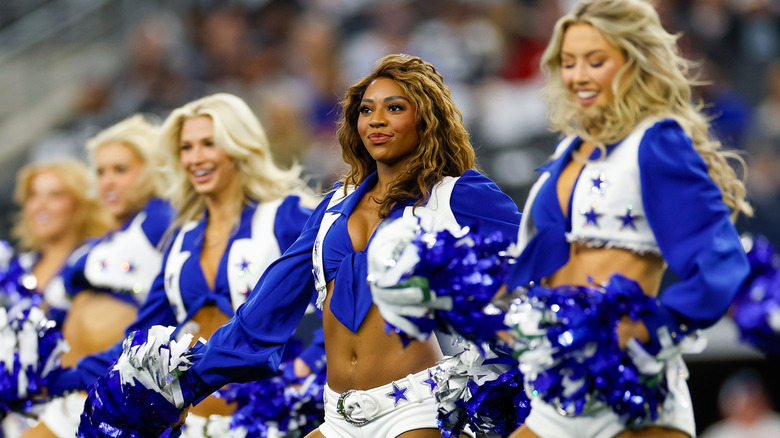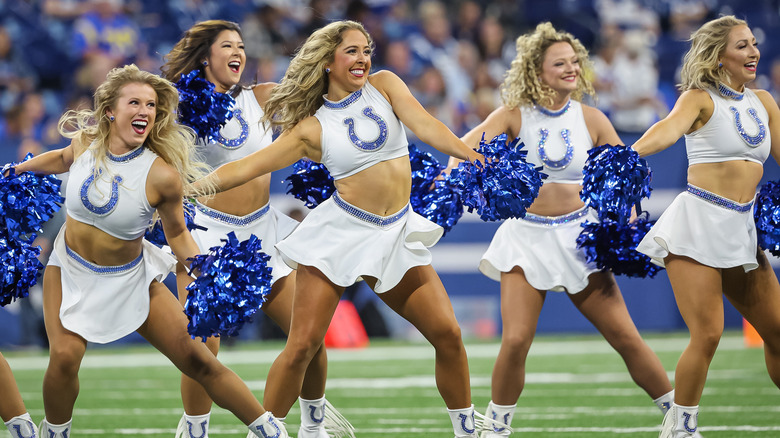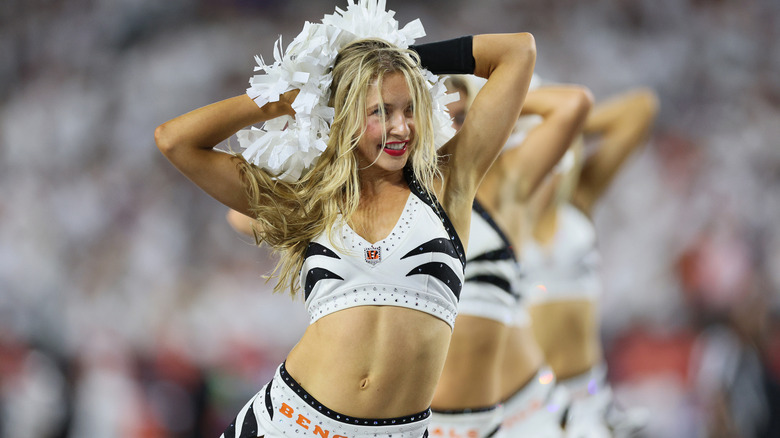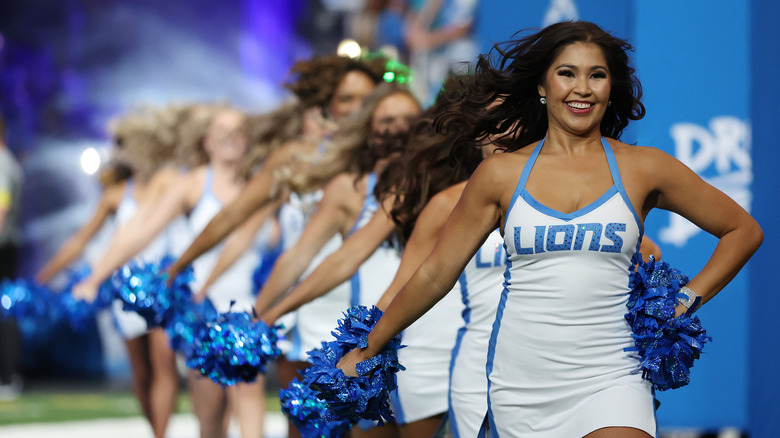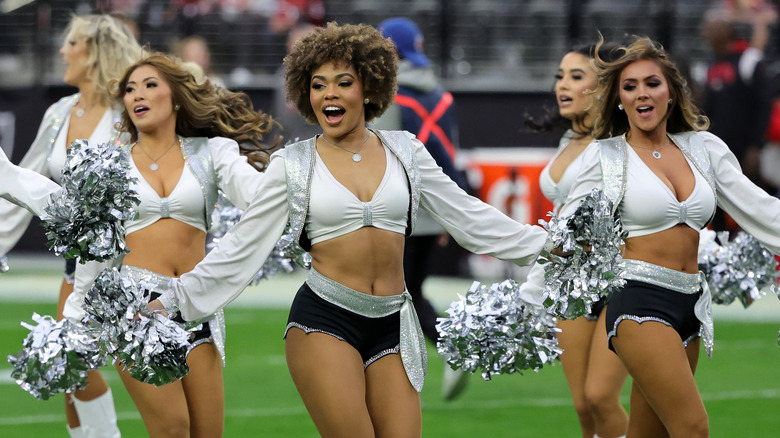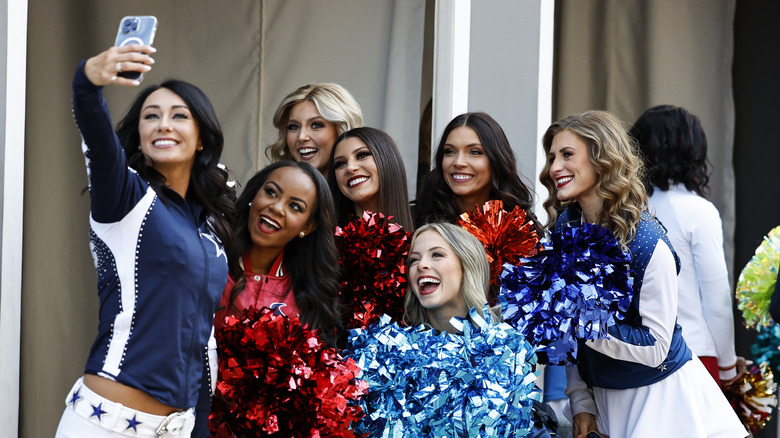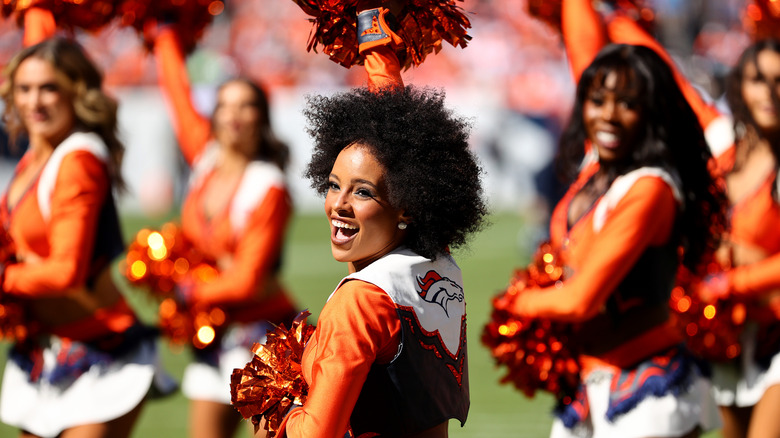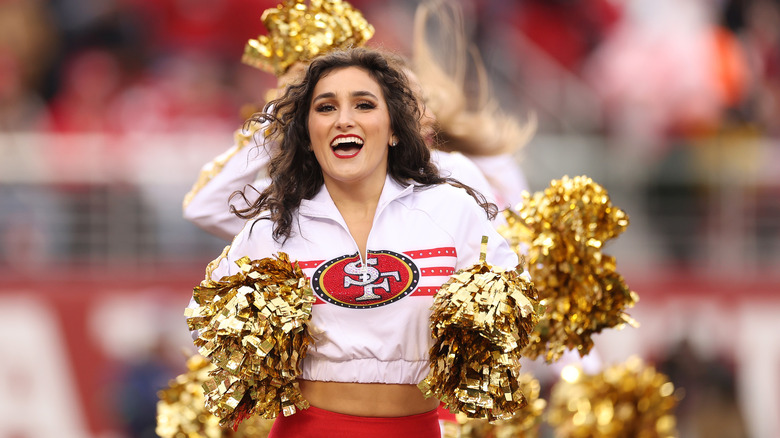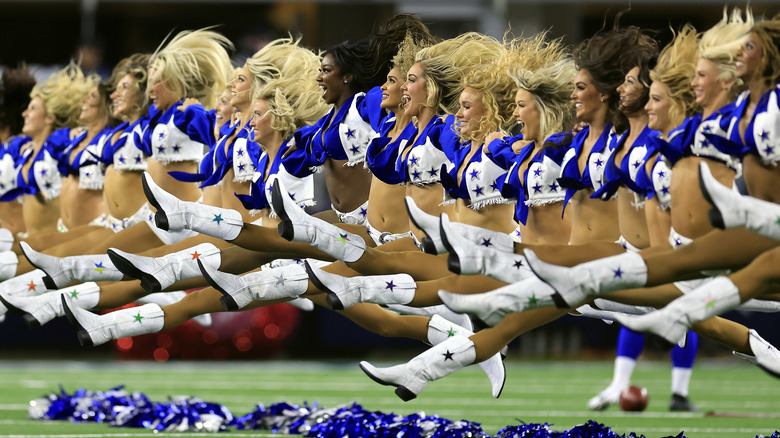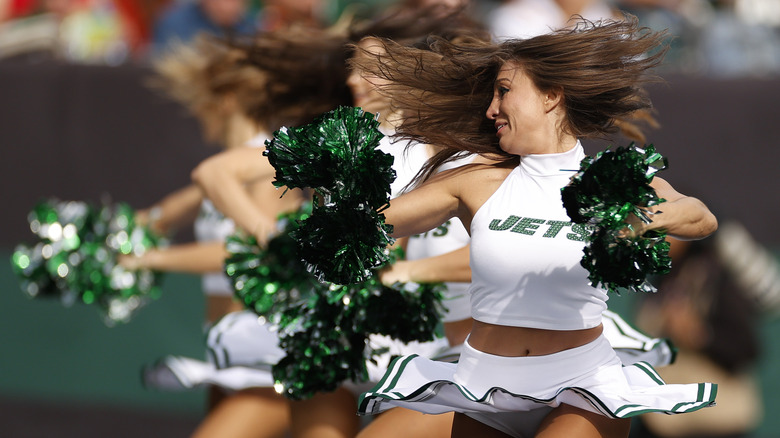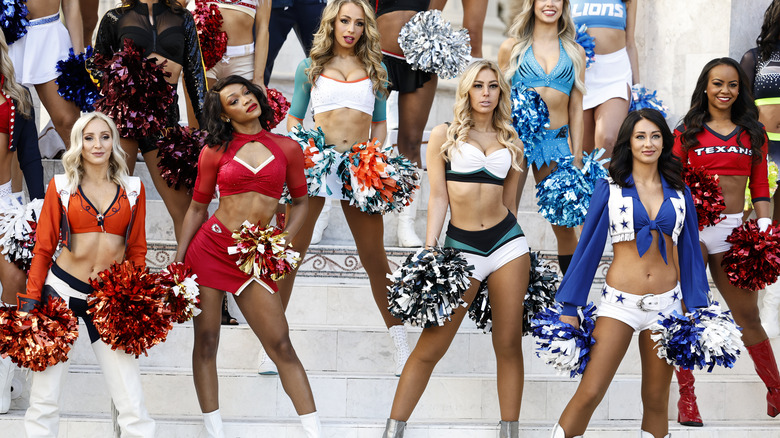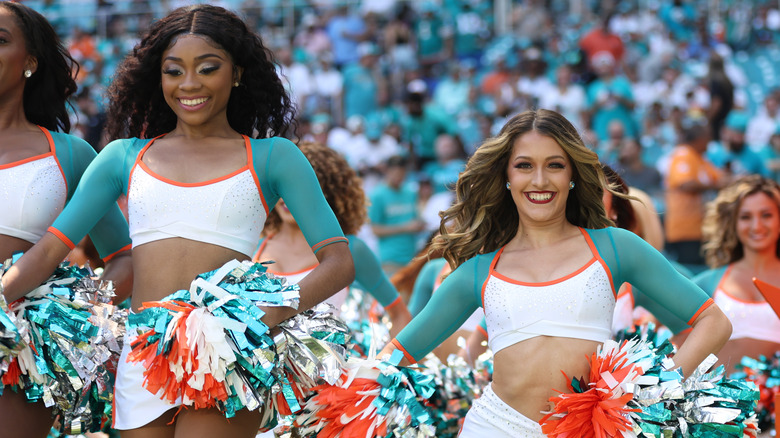Weird Rules NFL Cheerleaders Have To Follow
Pro football is a quintessential part of American life. Each season, the National Football League's games host thousands of in-person spectators, while millions more tune in from home to watch the drama and glory unfold in real time. And lest we forget about the Super Bowl, an annual staple that entertains the masses with emotional moments, legendary halftime performances, and heartwarming commercials. Naturally, the football players themselves are the center of NFL hoopla. However, there's another group of NFL icons that have earned their place in the pop-cultural zeitgeist: the league's cheerleaders.
"In many ways, becoming an NFL cheerleader is the opportunity of a lifetime. It's a very busy lifestyle," a former Dallas Cowboys squadster told the Amstar travel agency. "For performers it's really a dream come true to be able to perform and dance, and then you mix that with the NFL and it's an amazing experience." But in the world of NFL cheerleading, it's not always high kicks and rah-rah-rahs. For one thing, NFL cheerleaders reportedly (per ESPN) earn as little as $2,780 per season despite working 30-40 hours per week. Several teams — including the New York Jets, the Oakland Raiders, and more — have faced lawsuits regarding paltry wages and other discriminatory practices against their cheerleaders. And if you think all of that is weird, let us assure you it's only the tip of the iceberg. These are all of the bizarre rules the NFL's pom-pom brigade must follow.
NFL cheerleaders must look polished at all times
NFL cheerleaders are the picture of perfection, from their pristine makeup to their radiant smiles. To say that their image seems curated is an understatement — in fact, NFL teams hold their cheerleaders to incredibly stringent, if not unrealistic, standards regarding their physical appearance. Many of these bizarre rules appear in the 2013 handbook for the Buffalo Bills' cheer team, the Buffalo Jills. Although the Bills disbanded their cheer squad in 2014, Deadspin notes that the handbook is "essentially the boilerplate rulebook for cheerleaders around the league."
The Jills handbook demonstrates how NFL teams control nearly every aspect of their cheerleaders' appearances, right down to their fingers and toes. The document states that "nails must be groomed" and should be "worn naturally without polish or with a French manicure only." It also commands: "Keep toenails lightly trimmed and clean. PEDICURES." Besides shouting about pedicures, the NFL makes it clear that cheerleaders should look their best on and off the field. That means no sweatpants are to be worn in public — even on their days off (via The New York Times).
In some cases, NFL teams choose cheerleaders' hairstyles and makeup looks; they even dictate which salons the squad can go to. In 2015, an anonymous former NFL cheerleader told Cosmopolitan, "We had to ask the coaches for permission to change our physical appearance (say, to get a haircut or highlights), unless, of course, management ordered the makeover."
They must maintain an ''ideal weight''
If you're already feeling uneasy about the rules NFL cheerleaders have to follow, brace yourself for this next tidbit: the league also dictates their body weight. In 2014, Deadspin obtained a copy of the Baltimore Ravens' 2009 handbook, which listed some pretty disturbing policies about weight. "Each player, male and female, is expected to maintain ideal body weight and physical look for the duration of your contract," the handbook stated. "Weigh-ins will be held at the discretion of the Ravens." In 2014, former Buffalo Jills accused the team of making them undergo "jiggle tests" to judge their body proportions. How do NFL teams enforce their invasive weight policies? According to numerous accounts, cheerleaders have their weight checked, sometimes as often as twice weekly.
In 2015, Cosmopolitan published a statement from an anonymous former NFL cheerleader. The writer described what she endured, stating, "We each received a list of every muscle group (back, inner thighs, outer thighs, quads, biceps, obliques, upper abs, etc.), with detailed comments on which ones we needed to change."
Not only do these policies have deeply sexist implications, but they also stem from racist beauty standards. As former cheerleader Mhkeeba Pate told The Guardian, non-white cheerleaders could face extra scrutiny over their natural body proportions. "Sometimes as an African American cheerleader, you're being questioned about your body or your diet or your exercise because you have hips," Pate explained.
NFL cheerleaders pay for their own uniforms
NFL cheerleader uniforms are an iconic symbol of team spirit. Some uniforms, like those donned by Dallas Cowboys cheerleaders, are so famous that stars like Dolly Parton have cosplayed in them. But behind those glitzy, glamorous garments lies a bizarre rule. Numerous sources revealed that NFL cheerleaders — not the teams themselves — are financially responsible for these emblematic ensembles. And they're not cheap. According to the 2013 Buffalo Jills handbook: "Each member is responsible for purchasing her own, traditional uniform set. Approximate cost of a new uniform is $600+."
By contrast, the Seattle Seahawks Dancers get their uniforms on loan from the team; however, cheerleaders are on the hook for maintenance and professional cleanings. And that's not the only expense that NFL cheerleaders incur, despite reportedly earning around $250 per game. They must also foot the bill for hair, makeup, tights, teeth whitening, spray tans, and more. "I always had to have my nails painted nude or with a French tip," a former NFL cheerleader told Cosmopolitan in 2018. "I always had to have a spray tan. I had to pay for those things, and hair and makeup, on my own." A former Raiderette named Lacy T. revealed that her hair upkeep cost around $150 per session. "I was just hustling," Lacy told ESPN. "Very early on, I was spending money like crazy."
They must hide tattoos and body piercings
Considering their strict hair, makeup, and manicure policies, it's no surprise that NFL teams forbid cheerleaders from having visible tattoos and piercings. According to the 2013 Buffalo Jills handbook, these body modifications should never see the light of day. "The only piercings permitted are 1 in each ear," the document states. "Other piercings cannot be worn while auditioning or while in Jills uniform." Regarding ink, the handbook says, "Visible tattoos must be covered with a thick, waterproof foundation to match your skin tone."
But tattoos and piercings aren't the only things subject to bodily regulations. NFL teams also dictate cheerleaders' grooming and hygiene. The Jills handbook provides a list of acceptable cleanliness practices covering everything from foot fungus to menstruation. Regarding bath time, the NFL team gave an impassioned statement about certain bathing utensils. "Do not use lufa's [sic] or sponges," the handbook stresses. "They hold TONS of germs! Throw them away now!" Despite their hatred for loofahs and sponges, the handbook doesn't mention any alternatives to these scrubbing apparatuses.
They must be careful about what they post on social media
In 2018, the New Orleans Saints courted controversy when they fired a cheerleader for allegedly breaking their social media policy. The spurned pom-pom-shaker was a young woman named Bailey Davis, and she responded by slapping the franchise with a discrimination lawsuit. In a conversation with Cosmopolitan, Davis explained that it all started when she took a photo of herself wearing a semi-sheer one-piece and shared it on her private Instagram account. A teammate warned her to take it down, prompting Davis to delete the photo shortly after posting it. "But it was too late," Davis recalled. She added, "The meeting was humiliating. A Saints executive ... said that I had a "dirty face" and that he'd never let his granddaughters post something like that." The coach then contacted Davis' mother and demanded that the cheerleader "resign immediately or be terminated."
According to The New York Times, Bailey's supposed misdeed was "breaking rules that prohibit cheerleaders from appearing nude, seminude, or in lingerie" on social media. However, some team policies extend far beyond the types of content cheerleaders can or cannot share. When it comes to social media, cheerleaders must follow a laundry list of dos and don'ts — such as do add your boss on social media. As the 2009 Baltimore Ravens handbook explained: "If you participate in any social networking sites, such as MySpace or Facebook, you are required to 'Friend Request' your director."
NFL cheerleaders aren't allowed to interact with players
Bailey Davis' lawsuit against the New Orleans Saints didn't just focus on their social media regulations; it also zeroed in on their "anti-fraternization" policy, which forbids cheerleaders from interacting with NFL players. Speaking with Cosmopolitan, Davis revealed that NFL cheerleaders are told to avoid players on and off the field. "I couldn't ever be in the same place as a player," the ex-cheerleader recalled. "If I were eating in a restaurant and a player walks in, I had to leave." She added, "If a player spoke to me in person, I could only use two phrases: 'hello' or 'good game.' Anything past that was fraternizing. I was supposed to end the conversation and walk away from them." Davis pointed out that these rules didn't work both ways: NFL players were never instructed to stay away from cheerleaders, yet cheerleaders were expected to uphold boundaries with players.
Davis' allegations raised copious eyebrows, including those of the American Bar Association. In a 2020 review, the group questioned the league's social media policies, noting that they hinged on sexist stereotypes. They argued that the Saints had directed their policies toward the wrong group. "If NFL teams believe female cheerleaders need to be protected from aggressive male NFL players, it would make more sense to require the football players to be subject to the anti-fraternization policy's burdens as well," the group wrote.
The NFL says no to underwear, yes to gum chewing
In addition to looking prim and proper, NFL teams expect cheerleaders to look flawless in their uniforms. Outfits should be clean, crisp, and free of any blemishes — including the dreaded panty line. To ward off lingering lines or unsightly straps, NFL teams forbid their cheerleaders from wearing underwear. This policy appeared in the Cincinnati Bengals handbook, which stated that "no panties are to be worn under practice clothes or uniform, not even thong panties."
Conversely, bras are highly encouraged. In their 2014 handbook (via Deadspin), the Bengals mention a strict policy against "slouching breasts." This cringe-worthy rule, however, does contain some caveats. Bras must be nude or black, and lacy garments are strictly prohibited.
NFL teams may have a weird stance on underwear, but their policy on gum chewing is even more confusing. In most cases, gum chewing is off-limits. However, there are occasions when gum chewing is a requirement. These Bizarro-world policies are outlined in the Seattle Seahawks handbook, which states that cheerleaders must chomp a mouthful of gum whenever their director commands them to (via CBS News). If these strange rules have your head spinning, don't worry — we're right there with you.
They're forbidden from expressing their opinions
Most of us don't give much thought to the inner worlds of NFL cheerleaders. After all, they're not the ones making headlines; that honor belongs to NFL golden boys like Kansas City Chiefs player Travis Kelce. NFL cheerleaders are expected to remain in the background, but that rule doesn't apply to the players. Case in point: in 2016, former NFL star Colin Kaepernick made a powerful (and controversial) statement when he took a knee during the National Anthem in an act of protest against racism and police brutality. Several athletes expressed solidarity with the football hero, but NFL cheerleaders remained silent.
The refusal of NFL cheerleaders to take a hardline political stance might be explained by NFL teams' rules regarding their conduct. The Jills handbook, for example, prohibited cheerleaders from talking about politics, religion, and even their personal lives. "Do not be overly opinionated about anything," said the document. "Be positive and consistently optimistic about everything ... Never complain!"
Regarding Kaepernick, a former Jaguars cheerleader told Elle that cheerleaders "wouldn't take a knee" because they're "a little fish in a big pond." Another former cheerleader, Danetha Doe, challenged the NFL's policy about suppressing cheerleaders' opinions. "There's a bigger conversation to be had here," Doe said. "Why, as women, aren't we a bigger part of these conversations? Why isn't our opinion valued as highly as others? We have fans as well. Why isn't the league interested in hearing what we have to say?"
They must follow oddly specific rules when eating
NFL teams don't just dictate cheerleaders' behavior during games and practice — they also scrutinize the pep squad's eating habits. And cheerleaders had better eat with the utmost grace, because the NFL is always watching. According to the Buffalo Jills' 2013 handbook, each bite should be methodical and mannerly. Furthermore, NFL cheerleaders should never eat in uniform.
In case a Buffalo Jill forgot how to use a soupspoon, the handbook would've had their back. "Dip the spoon into the soup, moving it away from the body, until it is about two-thirds full," the rulebook instructed. "Then sip the liquid, without slurping, from the side of the spoon without inserting the whole spoon into the mouth." According to the Buffalo Bills, pasta-eating is also a precarious matter, but luckily, their handbook explained the process in ample detail. The rules stated, "If you are served pasta, never cut it to eat. Twirl a small portion on your fork with the assistance of a spoon."
Likewise, the Oakland Raiders also have a list of weird mealtime instructions. According to their "dining etiquette" section, it's essential to be polite, even if you're not a fan of what's on your plate. "If you don't like your meal, try a little of everything and strategically move the rest around your plate," says the squad manual, which The Los Angeles Times obtained in 2014.
Calendar shoots are non-negotiable
Each year, NFL teams whisk their cheerleaders off to faraway destinations where they slip into bikinis and strike the sultry poses that will grace the pages of the NFL Cheerleader Calendar. According to Dallas Cowboys cheer director Kelli Finglass, it's the ultimate right of passage for squad members. "Imagine going to an area like this for eight days with 21 of your best friends," Finglass raved to Amstar. "It's just an incredible, fun, exciting, glamorous, and exotic adventure."
Of course, even the glitziest situations come with potential hurdles, and calendar shoots can quickly go sour due to bad weather, long days, and early start times. But regardless of the difficulties, cheerleaders must follow through with their calendar shoot obligations — after all, they are non-negotiable.
Once the calendars are complete, NFL cheerleaders must promote and sell them. That might not seem like an outlandish requirement, but it gets weirder. As The New York Times reported, New Orleans Saints cheerleaders had to stand in the parking lot on game days and hawk calendars to fans as they entered the stadium. If a cheerleader didn't meet their 20-calendar sales quota, they'd have to try and sell more during the game. According to the 2009 Baltimore Ravens Handbook (via Deadspin), cheerleaders had to purchase calendars in bulk before selling them. Women on the squad were required to buy 100 calendars per season, whereas men were only on the hook for 20 calendars.
They can be fined for breaking the rules
The consequences could be dire if an NFL cheerleader fails to follow their team's rules. Several team handbooks state that rogue cheerleaders could be benched — or worse, fired — if they violate protocol. In addition to these punishments, cheerleaders could incur fines for unruly behavior.
In 2014, a former NFL cheerleader named Lacy T. sued the Oakland Raiders, citing numerous wage and labor law violations. The scorned Raiderette brought ample receipts, including a "schedule of fines" published and distributed by the team. According to the document, cheerleaders were fined $10 for showing up to practice with the wrong set of pom-poms. If their workout clothes weren't by the book, a $10 fee would apply. For unpolished boots, another $10 fine. In the case of an especially egregious offense, a cheerleader could be forced to sit out during a game, resulting in a loss of compensation for that day.
If Raiderettes disagree with their fines, they can appeal them to the team's cheer director. However, the director is the one who issues fines in the first place, so, as Deadspin pointed out, appealing would probably be a lost cause.
